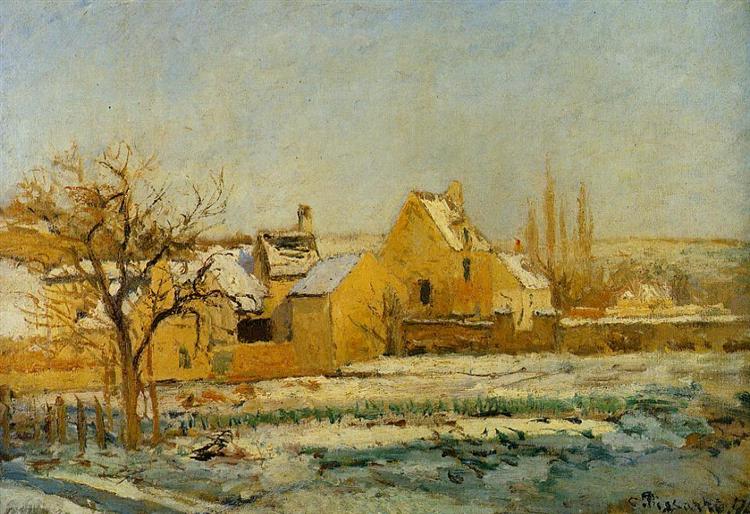תיאור
Camille Pissarro's painting "The Effect of Snow at the Hermitage", painted in 1874, is an outstanding testament to Impressionism, an artistic movement in which Pissarro became a key figure. Today, when looking at this work, we are immersed in a winter landscape that not only captures the essence of nature, but also reflects a deep understanding of light and colour that characterises Pissarro's work.
Beginning with the composition, the canvas opens onto a setting that presents a view of the Hermitage, a significant landmark in history and culture. The perspective is cleverly arranged, leading the viewer’s gaze through a narrow path that leads into the snowy landscape. The backdrop is dominated by the shadow of snow-covered trees, suggesting an atmosphere of winter calm and serenity. These elements are representative of the pastoral style that Pissarro cultivated, where the natural surroundings seem to invite the observer to stop and appreciate the peace emanating from the scene.
The use of color in this work is particularly notable. Pissarro combines cool shades of blue and gray that evoke the crisp freshness of winter, while using quick, loose brushstrokes that bring vitality to the image. The snowy surfaces of the landscape are rendered in a soft white, infused with nuances that vary in tone under the light. This attention to color and light reflects the Impressionist obsession with capturing ephemeral moments, where each instant seems to be treasured in pigments. Shadows, moreover, play a crucial role, giving the snow a palpable, three-dimensional texture that lends depth to the canvas.
As for the characters, although there are human figures visible in the painting, these are only suggestions of life in the landscape rather than focal points. Their presence, almost ghost-like, blurs into the vastness of the surroundings. This could be interpreted as a call for intimacy between the viewer and nature, suggestive of Pissarro’s focus on the interrelationship between humanity and the natural environment. By observing the tiny silhouettes on the road, we are reminded that we are part of this vast world, subjugated by its beauty and fragility.
Interestingly, Pissarro is known not only for his role in Impressionism, but also for his commitment to Realism. This is manifested in his ability to capture nature as it is, without idealization, but with an inherent beauty that transforms the everyday into something extraordinary. This work, in particular, can be seen as a bridge between the Realist style and Impressionist principles, capturing a moment that feels both anecdotal and mystical.
When exploring The Effect of Snow on the Hermitage, it is important to consider its connection to other winter landscapes painted by his contemporaries. Works such as Claude Monet's The Garden of the Infant and Alfred Sisley's Winter share this fascination with winter light, but each artist approaches the subject in a unique way. Pissarro's influence is felt in his treatment of changing light and his inclusive view of the environment.
Ultimately, this work not only stands as a depiction of a snowy landscape in 1874, but also invites us to reflect on the interaction between human beings and nature in its purest state. Pissarro’s art continues to resonate with the modern viewer, reminding us of the beauty of the everyday and the importance of observing the world with fresh eyes. In a world that often feels rushed and disconnected from its surroundings, “The Effect of Snow at the Hermitage” becomes a perennial reminder of the calm and wonder that can be found in the simplest and subtlest moments of life.
KUADROS ©, a famous painting on your wall.
Hand-made oil painting reproductions, with the quality of professional artists and the distinctive seal of KUADROS ©.
Painting reproduction service with satisfaction guarantee. If you are not completely satisfied with the replica of your painting, we will refund 100% of your money.

